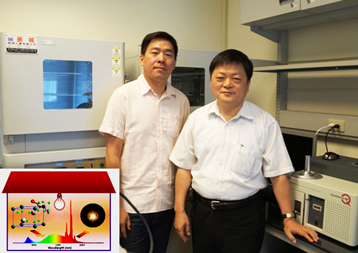

 |
||
|
::: Research Revolutionizes Warm White LED Performance and Production Cost |
||
|
A National Taiwan University research team has discovered that a highly efficient non-rare-earth red phosphor may be able to expand the commercial application of LED usage. The research paper documenting this breakthrough conducted by the NTU team in collaboration with China's Fujian Institute of Research on the Structure of Matter (FJIRSM) has been published in Nature Communications this June.  Team led by Prof. Ru-Shi Liu (right) and researcher Chun-Che Lin (left) discover how to cost-effectively create stable and efficient warm white LEDs using non-rare-earth red phosphors. The creation of LED (light-emitting diodes) lighting technology has greatly improved the efficiency of electronic lighting, yet application of prevalent blue-chip based LEDs have been limited to general indoor lighting as current technology is unable to efficiently create warmer lighting at lower correlated color temperatures (CCT < 4500 K) and higher color rendering indexes (CRI > 80). The key to addressing this limitation lies in the ability to efficiently synthesize warmer color schemes (i.e. red phosphor) with blue-chip based LEDs. As Mn4+-activated fluoride compounds are emerging as a new class of non-rare-earth red phosphors for high-efficacy warm white LEDs, the joint research team, which includes NTU Chemistry Professor Ru-Shi Liu (劉如熹), postdoctoral researcher Chun-Che Lin (林群哲), and FJIRSM Professor Xue-Yuan Chen (陳學元), focused on this substance in finding that a general but convenient strategy based on efficient cation exchange reaction, which had so far been considered effective only in synthesizing nano-sized materials, is capable of producing a stable and efficient photoluminescence yield of as high as 98%. The team points out that in addition to producing efficient warm lighting, the warm white LED can be reproduced with non-expensive materials at room temperature and ordinary pressure. As such, the research has opened the door to mass production and prospective commercial application. Moreover, the team’s in depth analysis on Mn4+ in revealing the structure of its electronic energy level also serves as an important theoretical basis for future explorations of novel non-rare-earth red emitting phosphors. Professor Ru-Shi Liu and his team’s recent study in inorganic luminescent material have focused on both fundamental and practical applications. Their research, as a result, has been published in a number of internationally acclaimed journals such as the Angewandte Chemie International Edition, Journal of the American Chemical Society, and Chemistry of Materials. The team team has also received over 60 patents so far. For more information on the research, access the original article HERE. |
||
No. 1, Sec. 4, Roosevelt Road, Taipei, 10617 Taiwan(R.O.C.)
Phone: +886-2-3366-3366 Fax: +886-2-2362-7651